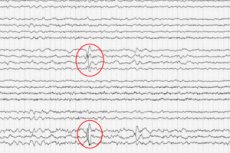Medical expert of the article
New publications
Cryptogenic epilepsy in children
Last reviewed: 07.07.2025

All iLive content is medically reviewed or fact checked to ensure as much factual accuracy as possible.
We have strict sourcing guidelines and only link to reputable media sites, academic research institutions and, whenever possible, medically peer reviewed studies. Note that the numbers in parentheses ([1], [2], etc.) are clickable links to these studies.
If you feel that any of our content is inaccurate, out-of-date, or otherwise questionable, please select it and press Ctrl + Enter.

This medical report is not a final diagnosis; symptoms may change with age and develop into a known form, or they may regress.
Cryptogenic epilepsy includes the most well-known epileptic syndromes that manifest in childhood.
- West syndrome (infantile or infantile spasms) first appears in infancy. This diagnosis is already present in babies aged four to six months, male infants are more susceptible to this disease. The syndrome is characterized by frequent seizures that do not respond to drug therapy. An electroencephalogram shows chaotic cerebral hyperactivity, and the child's early psychomotor development is impaired.
- Lennox-Gastaut syndrome manifests itself in older children with the following symptoms: children suddenly fall (atonia), while maintaining consciousness, sometimes passing out for literally a moment. They usually do not have convulsions. The seizure passes very quickly and the child is already on his feet.
In this syndrome, paroxysms of falls may be observed within asthenic-astatic, myoclonic-static, tonic seizures, atypical absences. Most often, Lennox-Gastaut syndrome is diagnosed in four- to six-year-old children, however, it can also occur in two- to three-year-old children and in eight-year-olds.
In approximately half of the cases, West syndrome was diagnosed in infancy; in other cases, Lennox-Gastaut syndrome manifested itself as an independent disease after two years of age.
Tonic seizures occur at any time of the day and are varied. They are characterized by: sudden bending of the neck and body; the patient's arms are usually raised up in a semi-bent position. Contractions of the facial muscles are noticeable, the patient rolls his eyes, his face turns red and his breathing stops.
Lennox-Gastaut syndrome is also characterized by atypical absences, which are distinguished by a variety of symptoms. At the same time, consciousness may be present to some extent, as well as partial motor and speech activity. Hypersalivation, complete or partial absence of facial expressions, myoclonus of the mouth and eyelids, and various atonic phenomena are also common: the head falls helplessly onto the chest, the mouth opens slightly. Atypical absences often occur against the background of decreased muscle tone, which looks like a "limpness" of the body, usually starting from above - with the facial and neck muscles. Intellectual deficit in the cryptogenic variant of this syndrome develops immediately after the onset of attacks.
- Generalized convulsive seizures manifest the myoclonic-astatic form of cryptogenic epilepsy. This usually occurs between the ages of ten months and five years. Most often, such seizures manifest at 1-3 years, closer to the age of five, myoclonic and myoclonic-astatic seizures appear. Externally, the seizure looks like convulsive very fast movements of the arms and legs, combined with frequent nodding of the head, a light pulsating spasm running through the body. The patient falls, as if he was hit in the knees. Seizures mostly occur in the morning, after getting out of bed.
The symptoms of epileptic seizures also differ depending on the age group of patients.
In infancy, seizures may be confused with febrile seizures or hyperactivity. The infant may develop a fever, become whiny and irritable, and seizures usually begin on one side of the body and gradually move to the other. Foamy hypersalivation, as well as sleep and appetite disturbances, are usually not observed.
In early childhood, there are usually no convulsions. Seizures occur in the form of detachment from the surrounding reality. The child freezes with a concentrated look "into himself", does not respond to treatment.
Schoolchildren, especially males, complain of paresthesia of the skin and mucous membrane of the oral cavity and larynx. The lower jaw shifts to the side, the teeth chatter, the tongue trembles, there is increased salivation and slurred speech. The attacks often begin in sleep.
Teenagers experience muscle convulsions throughout the body, tension in the trunk and limbs against the background of a fainting state, involuntary emptying of the intestines and bladder. During a seizure, patients often turn their heads, throwing them back to one side or another.


 [
[